Citroen C4 PICASSO 2011.5 1.G Owner's Guide
Manufacturer: CITROEN, Model Year: 2011.5, Model line: C4 PICASSO, Model: Citroen C4 PICASSO 2011.5 1.GPages: 352, PDF Size: 9.83 MB
Page 31 of 352
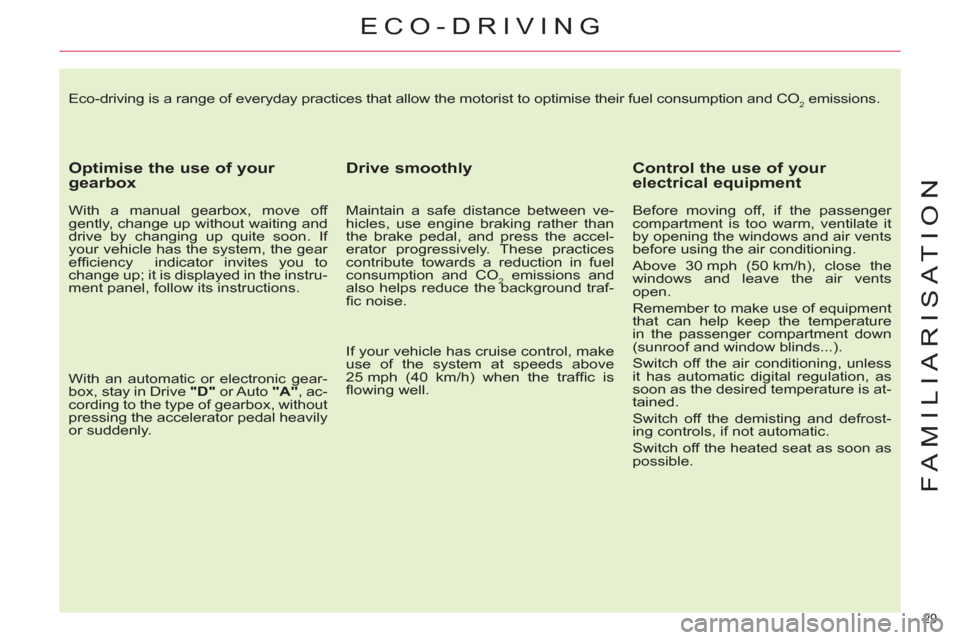
29
FAMILIARISATION
Eco-driving is a range of everyday practices that allow the motorist to optimise their fuel consumption and CO2 emissions.
Optimise the use of your
gearbox
With a manual gearbox, move off
gently, change up without waiting and
drive by changing up quite soon. If
your vehicle has the system, the gear
effi ciency indicator invites you to
change up; it is displayed in the instru-
ment panel, follow its instructions.
With an automatic or electronic gear-
box, stay in Drive "D"
or Auto "A"
, ac-
cording to the type of gearbox, without
pressing the accelerator pedal heavily
or suddenly.
Drive smoothly
Maintain a safe distance between ve-
hicles, use engine braking rather than
the brake pedal, and press the accel-
erator progressively. These practices
contribute towards a reduction in fuel
consumption and CO
2 emissions and
also helps reduce the background traf-
fi c noise.
If your vehicle has cruise control, make
use of the system at speeds above
25 mph (40 km/h) when the traffi c is
fl owing well.
Control the use of your
electrical equipment
Before moving off, if the passenger
compartment is too warm, ventilate it
by opening the windows and air vents
before using the air conditioning.
Above 30 mph (50 km/h), close the
windows and leave the air vents
open.
Remember to make use of equipment
that can help keep the temperature
in the passenger compartment down
(sunroof and window blinds...).
Switch off the air conditioning, unless
it has automatic digital regulation, as
soon as the desired temperature is at-
tained.
Switch off the demisting and defrost-
ing controls, if not automatic.
Switch off the heated seat as soon as
possible.
ECO-DRIVING
Page 32 of 352

30
FAMILIARISATION
Limit the causes of excess
consumption
Spread loads throughout the vehicle;
place the heaviest items in the bottom
of the boot, as close as possible to the
rear seats.
Limit the loads carried in the vehicle
and reduce wind resistance (roof bars,
roof rack, bicycle carrier, trailer...). Use
a roof box in preference.
Remove roof bars and roof racks after
use.
At the end of winter, remove snow tyres
and refi t your summer tyres.
Observe the recommendations
on maintenance
Check the tyre pressures regularly,
when cold, referring to the label in the
door aperture, driver's side.
Carry out this check in particular:
- before a long journey,
- at each change of season,
- after a long period out of use.
Don't forget the spare wheel and the
tyres on any trailer or caravan.
Have your vehicle serviced regularly (en-
gine oil, oil fi lter, air fi lter...) and observe
the schedule of operations recommended
by the manufacturer.
When refuelling, do not continue after
the 3 rd cut-off of the nozzle to avoid
any overfl ow.
At the wheel of your new vehicle,
it is only after the fi rst 1 800 miles
(3 000 kilometres) that you will see
the fuel consumption settle down to a
consistent average.
Switch off the headlamps and front
foglamps when the level of light does
not require their use.
Avoid running the engine before mov-
ing off, particularly in winter; your ve-
hicle will warm up much faster while
driving.
As a passenger, if you avoid connect-
ing your multimedia devices (fi lm, mu-
sic, video game...), you will contribute
towards limiting the consumption of
electrical energy, and so of fuel.
Disconnect your portable devices be-
fore leaving the vehicle.
Page 33 of 352
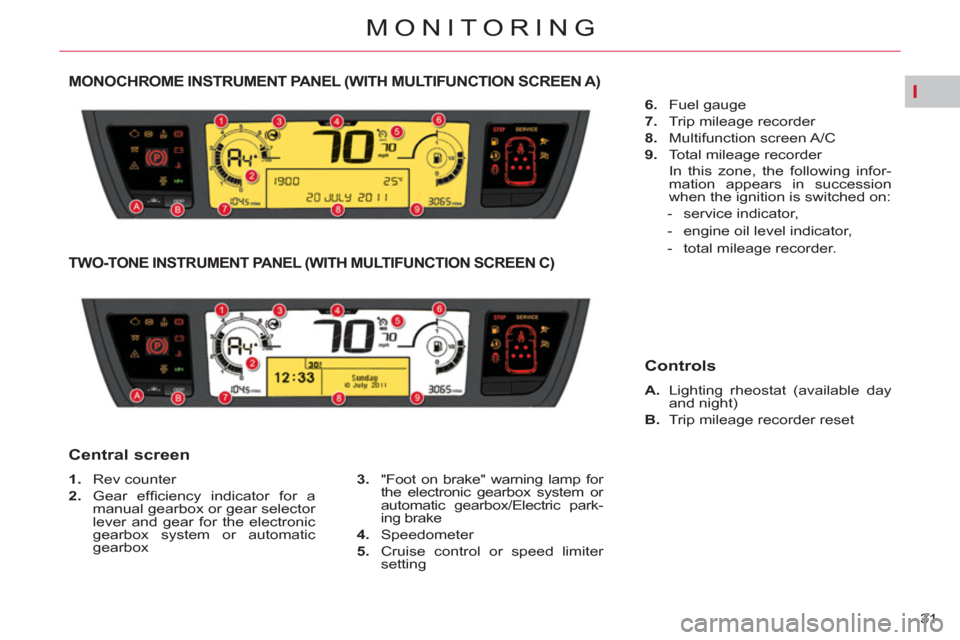
I
31
MONITORING
MONOCHROME INSTRUMENT PANEL (WITH MULTIFUNCTION SCREEN A)
1.
Rev counter
2.
Gear effi ciency indicator for a
manual gearbox or gear selector
lever and gear for the electronic
gearbox system or automatic
gearbox
3.
"Foot on brake" warning lamp for
the electronic gearbox system or
automatic gearbox/Electric park-
ing brake
4.
Speedometer
5.
Cruise control or speed limiter
setting
A.
Lighting rheostat (available day
and night)
B.
Trip mileage recorder reset
Central screen
Controls
TWO-TONE INSTRUMENT PANEL (WITH MULTIFUNCTION SCREEN C)
6.
Fuel gauge
7.
Trip mileage recorder
8.
Multifunction screen A/C
9.
Total mileage recorder
In this zone, the following infor-
mation appears in succession
when the ignition is switched on:
- service indicator,
- engine oil level indicator,
- total mileage recorder.
Page 34 of 352

I
32
MONITORING
INSTRUMENT PANEL WITH MyWayOR NaviDriveMULTIFUNCTION
SCREEN
1.
Cruise control or speed limiter
setting
2.
Speedometer
3.
MyWay or NaviDrive multifunc-
tion screen
4.
Rev counter
5.
"Foot on brake” warning lamp for
the electronic gearbox system or
automatic gearbox/Electric park-
ing brake
6.
Fuel gauge
A.
Lighting rheostat (available day
and night)
B.
Trip mileage recorder reset
Central screen
Controls
7.
Gear effi ciency indicator for a
manual gearbox or selector lever
position and gear for the elec-
tronic gearbox system or auto-
matic gearbox
8.
Trip mileage recorder
9.
Total mileage recorder
In this zone, the following infor-
mation appears in succession
when the ignition is switched on:
- service indicator,
- engine oil level indicator,
- total mileage recorder.
10.
Warning lamp zone.
Page 35 of 352
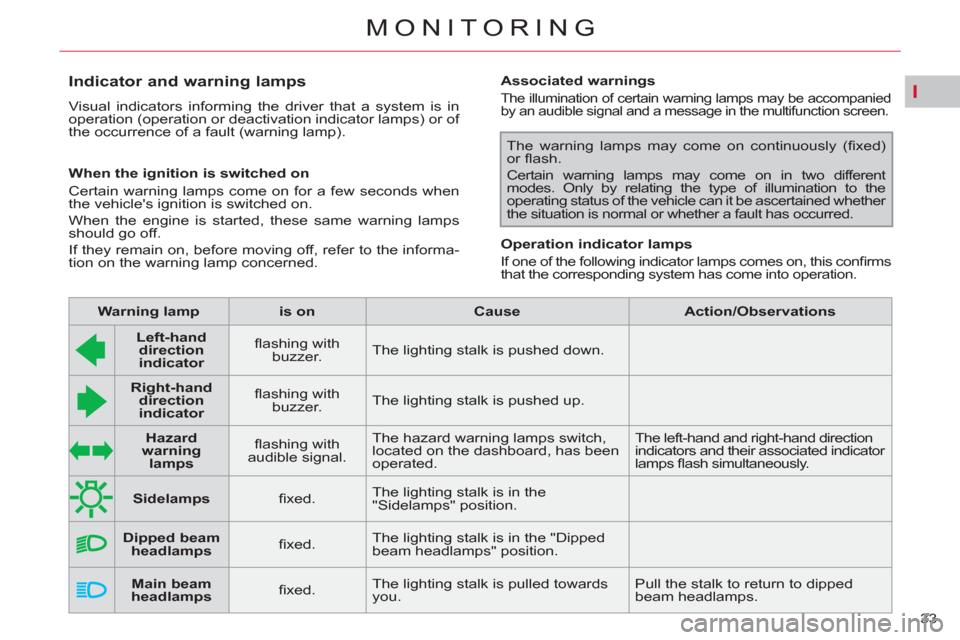
I
33
MONITORING
Indicator and warning lamps
Visual indicators informing the driver that a system is in
operation (operation or deactivation indicator lamps) or of
the occurrence of a fault (warning lamp).
When the ignition is switched on
Certain warning lamps come on for a few seconds when
the vehicle's ignition is switched on.
When the engine is started, these same warning lamps
should go off.
If they remain on, before moving off, refer to the informa-
tion on the warning lamp concerned.
Associated warnings
The illumination of certain warning lamps may be accompanied
by an audible signal and a message in the multifunction screen.
Operation indicator lamps
If one of the following indicator lamps comes on, this confi rms
that the corresponding system has come into operation.
The warning lamps may come on continuously (fi xed)
or fl ash.
Certain warning lamps may come on in two different
modes. Only by relating the type of illumination to the
operating status of the vehicle can it be ascertained whether
the situation is normal or whether a fault has occurred.
Warning lamp
is on
Cause
Action/Observations
Left-hand
direction
indicato
r
fl ashing with
buzzer. The lighting stalk is pushed down.
Right-hand
direction
indicator
fl ashing with
buzzer. The lighting stalk is pushed up.
Sidelamps
fi xed. The lighting stalk is in the
"Sidelamps" position.
Dipped beam
headlamps
fi xed. The lighting stalk is in the "Dipped
beam headlamps" position.
Main beam
headlamps
fi xed. The lighting stalk is pulled towards
you. Pull the stalk to return to dipped
beam headlamps.
Hazard
warning
lamps
fl ashing with
audible signal. The hazard warning lamps switch,
located on the dashboard, has been
operated. The left-hand and right-hand direction
indicators and their associated indicator
lamps fl ash simultaneously.
Page 36 of 352
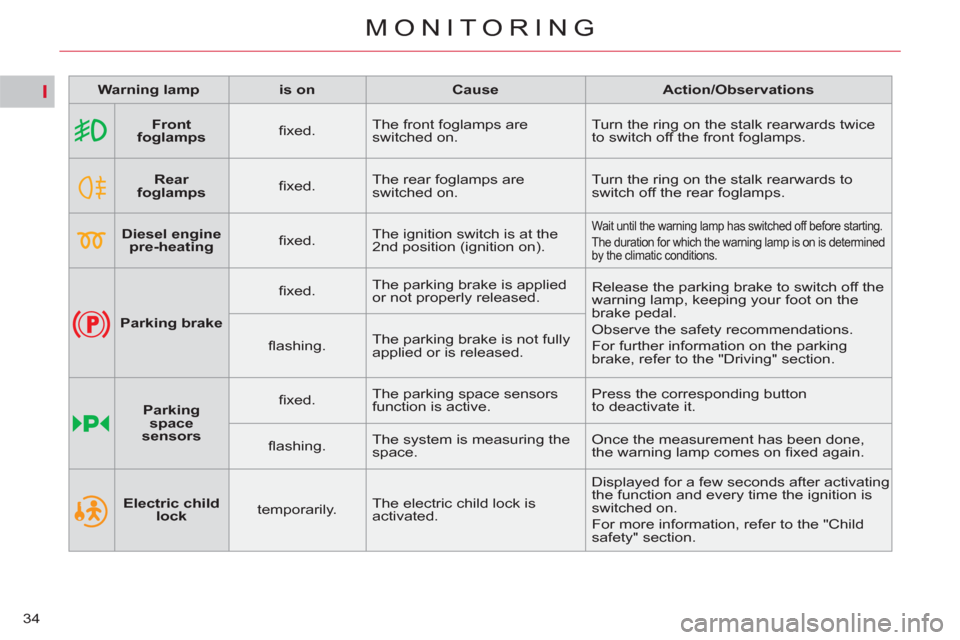
I
34
MONITORING
Warning lamp
is on
Cause
Action/Observations
Front
foglamps
fi xed. The front foglamps are
switched on. Turn the ring on the stalk rearwards twice
to switch off the front foglamps.
Rear
foglamps
fi xed. The rear foglamps are
switched on. Turn the ring on the stalk rearwards to
switch off the rear foglamps.
Diesel engine
pre-heating
fi xed. The ignition switch is at the
2nd position (ignition on).
Wait until the warning lamp has switched off before starting.
The duration for which the warning lamp is on is determined
by the climatic conditions.
Parking brake
fi xed. The parking brake is applied
or not properly released. Release the parking brake to switch off the
warning lamp, keeping your foot on the
brake pedal.
Observe the safety recommendations.
For further information on the parking
brake, refer to the "Driving" section.
fl ashing. The parking brake is not fully
applied or is released.
Parking
space
sensors
fi xed. The parking space sensors
function is active. Press the corresponding button
to deactivate it.
fl ashing. The system is measuring the
space. Once the measurement has been done,
the warning lamp comes on fi xed again.
Electric child
lock
temporarily. The electric child lock is
activated. Displayed for a few seconds after activating
the function and every time the ignition is
switched on.
For more information, refer to the "Child
safety" section.
Page 37 of 352
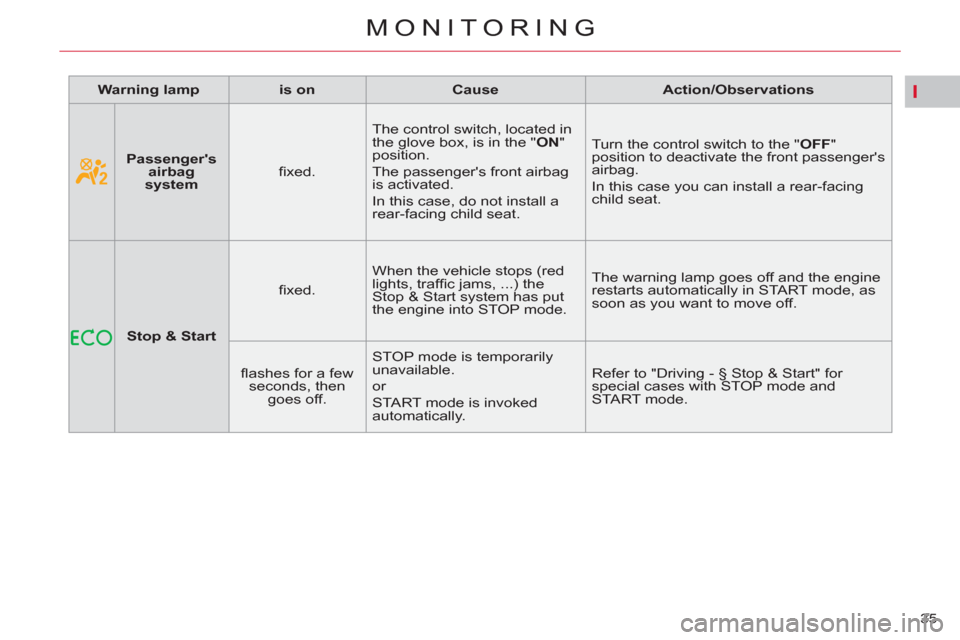
I
35
MONITORING
Warning lamp
is on
Cause
Action/Observations
Stop & Start
fi xed. When the vehicle stops (red
lights, traffi c jams, ...) the
Stop & Start system has put
the engine into STOP mode. The warning lamp goes off and the engine
restarts automatically in START mode, as
soon as you want to move off.
fl ashes for a few
seconds, then
goes off. STOP mode is temporarily
unavailable.
or
START mode is invoked
automatically. Refer to "Driving - § Stop & Start" for
special cases with STOP mode and
START mode.
Passenger's
airbag
system
fi xed. The control switch, located in
the glove box, is in the " ON
"
position.
The passenger's front airbag
is activated.
In this case, do not install a
rear-facing child seat. Turn the control switch to the " OFF
"
position to deactivate the front passenger's
airbag.
In this case you can install a rear-facing
child seat.
Page 38 of 352
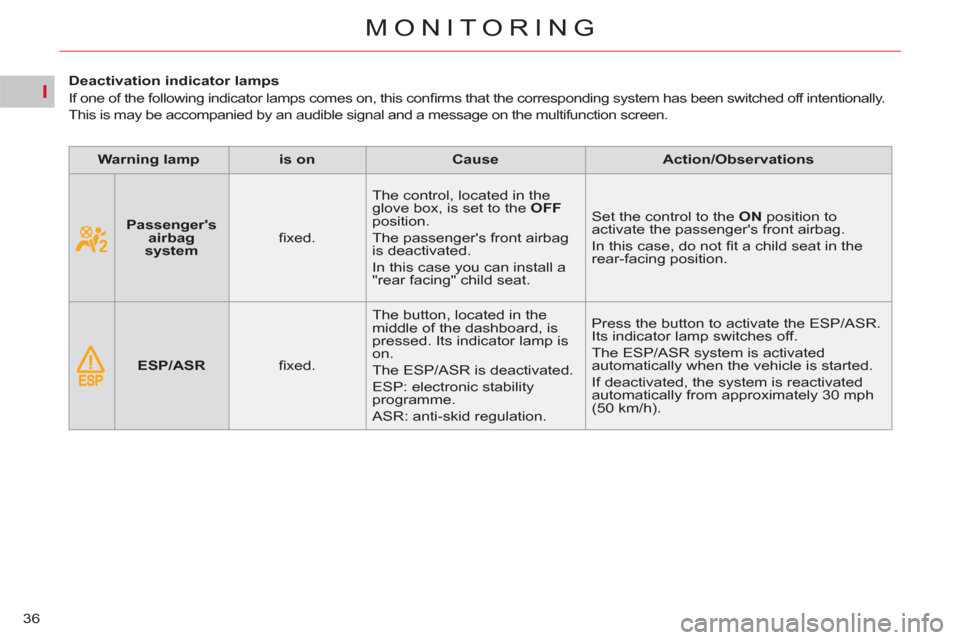
I
36
MONITORING
Deactivation indicator lamps
If one of the following indicator lamps comes on, this confi rms that the corresponding system has been switched off intentionally.
This is may be accompanied by an audible signal and a message on the multifunction screen.
Warning lamp
is on
Cause
Action/Observations
Passenger's
airbag
system
fi xed. The control, located in the
glove box, is set to the OFF
position.
The passenger's front airbag
is deactivated.
In this case you can install a
"rear facing" child seat. Set the control to the ON
position to
activate the passenger's front airbag.
In this case, do not fi t a child seat in the
rear-facing position.
ESP/ASR
fi xed. The button, located in the
middle of the dashboard, is
pressed. Its indicator lamp is
on.
The ESP/ASR is deactivated.
ESP: electronic stability
programme.
ASR: anti-skid regulation. Press the button to activate the ESP/ASR.
Its indicator lamp switches off.
The ESP/ASR system is activated
automatically when the vehicle is started.
If deactivated, the system is reactivated
automatically from approximately 30 mph
(50 km/h).
Page 39 of 352
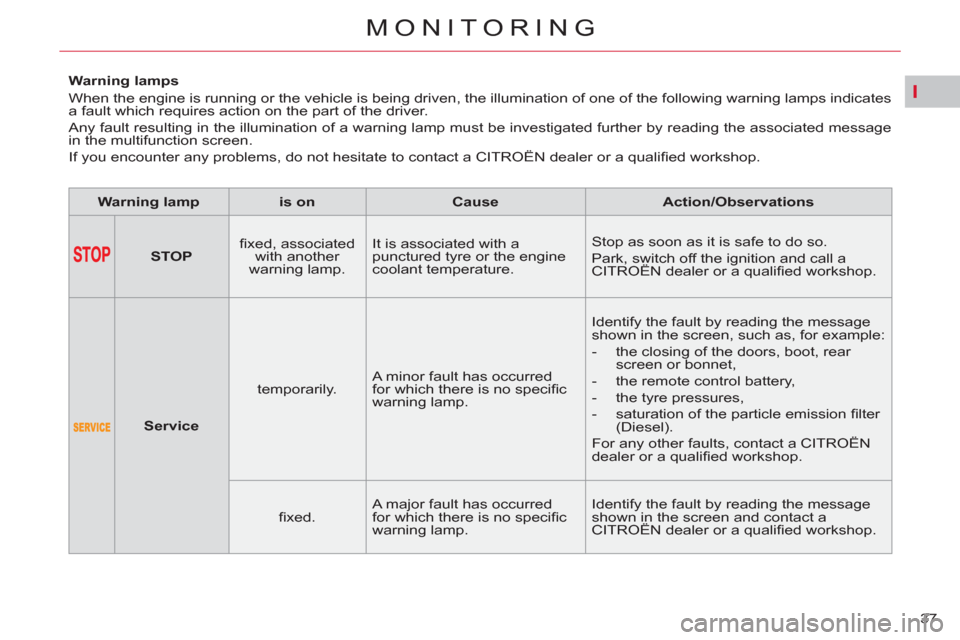
I
37
MONITORING
Warning lamps
When the engine is running or the vehicle is being driven, the illumination of one of the following warning lamps indicates
a fault which requires action on the part of the driver.
Any fault resulting in the illumination of a warning lamp must be investigated further by reading the associated message
in the multifunction screen.
If you encounter any problems, do not hesitate to contact a CITROËN dealer or a qualifi ed workshop.
Warning lamp
is on
Cause
Action/Observations
STOP
fi xed, associated
with another
warning lamp. It is associated with a
punctured tyre or the engine
coolant temperature. Stop as soon as it is safe to do so.
Park, switch off the ignition and call a
CITROËN dealer or a qualifi ed workshop.
Service
temporarily. A minor fault has occurred
for which there is no specifi c
warning lamp. Identify the fault by reading the message
shown in the screen, such as, for example:
- the closing of the doors, boot, rear
screen or bonnet,
- the remote control battery,
- the tyre pressures,
- saturation of the particle emission fi lter
(Diesel).
For any other faults, contact a CITROËN
dealer or a qualifi ed workshop.
fi xed. A major fault has occurred
for which there is no specifi c
warning lamp. Identify the fault by reading the message
shown in the screen and contact a
CITROËN dealer or a qualifi ed workshop.
Page 40 of 352
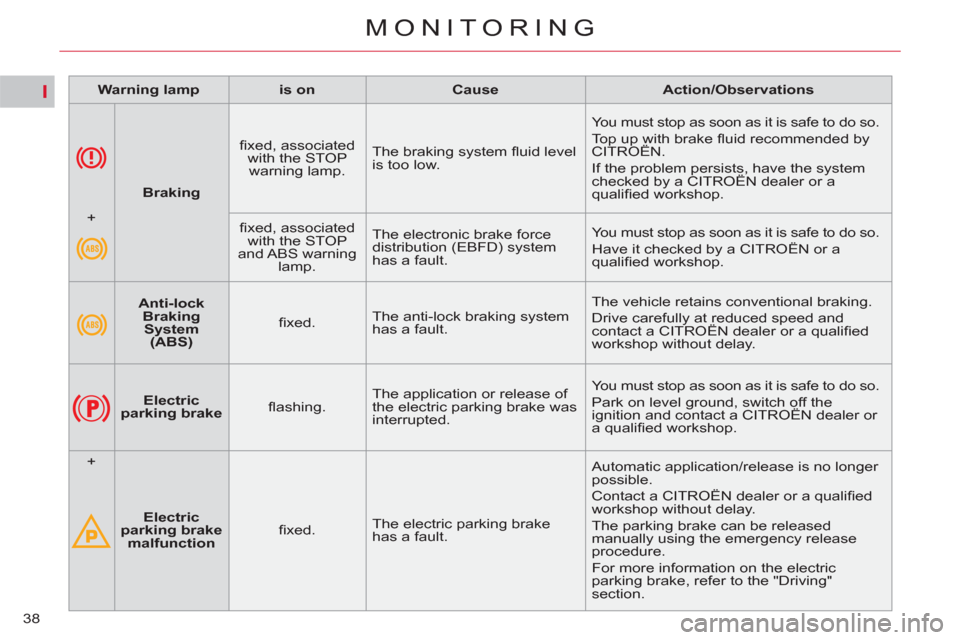
I
38
MONITORING
Warning lamp
is on
Cause
Action/Observations
Anti-lock
Braking
System
(ABS)
fi xed. The anti-lock braking system
has a fault. The vehicle retains conventional braking.
Drive carefully at reduced speed and
contact a CITROËN dealer or a qualifi ed
workshop without delay.
Electric
parking brake
fl ashing. The application or release of
the electric parking brake was
interrupted. You must stop as soon as it is safe to do so.
Park on level ground, switch off the
ignition and contact a CITROËN dealer or
a qualifi ed workshop.
+
Electric
parking brake
malfunction
fi xed. The electric parking brake
has a fault. Automatic application/release is no longer
possible.
Contact a CITROËN dealer or a qualifi ed
workshop without delay.
The parking brake can be released
manually using the emergency release
procedure.
For more information on the electric
parking brake, refer to the "Driving"
section.
Braking
fi xed, associated
with the STOP
warning lamp. The braking system fl uid level
is too low. You must stop as soon as it is safe to do so.
Top up with brake
fl uid recommended by
CITROËN.
If the problem persists, have the system
checked by a CITROËN dealer or a
qualifi ed workshop.
+
fi xed, associated
with the STOP
and ABS warning
lamp. The electronic brake force
distribution (EBFD) system
has a fault. You must stop as soon as it is safe to do so.
Have it checked by a CITROËN or a
qualifi ed workshop.